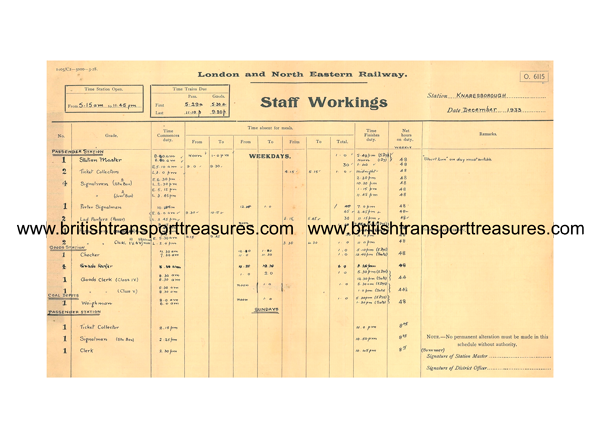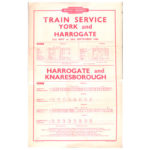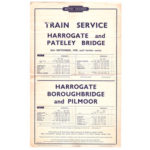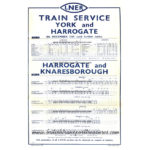Description
This is a graphic illustration of how labour intensive the steam worked railway was. At this period Knaresborough had a population of around 6,000 with trains approximately every hour during weekday to and from York, a handful of trains to and from Boroughbridge and Pilmoor, and a service of “Sentinel” steam railcars or “Push-Pull” auto trains every 15-20 minutes to and from Harrogate. These last were in competition with a parallel bus service run by the West Yorkshire Road Car Co. In this war the LNER had a not so secret weapon – the level crossing at Starbeck. The installations here included a locomotive shed servicing all engines working trains starting or terminating at Harrogate, a large goods depot and warehouse, a marshaling yard and landsale coal depots, all bisected by the A59 road. The movements between these elements added to the passenger service and the through freight trains between Leeds and Tesside bypassing Harrogate on the old Leeds Northern route through Starbeck, caused the gates to be closed across the road frequently. Doing so a minute or so earlier than necessary, and a slight delay in opening them could result in bus passengers being held up to see a train go through in each direction followed by a light engine or a shunting movement. Bus travelers soon got the message that it really was “Quicker by Train!”
The railway installations at Knaresborough were awkwardly situated being spread out over a distance of half a mile. The passenger station consisting of only two platforms occupied a cramped site between the famous viaduct and a tunnel under the High Street and its shops. A range of substantial stone single story buildings, one room thick, ran along one platform, a ramshackle collection of wood and corrugated iron structures ran along part of the other on the south side. Paradoxically these included a wooden hut called the “North Booking Office” probably a hangover from the days when the line from Starbeck was actually a branch off the Leeds Northern Railway. There was no room for anything but a very simple track layout – up and down lines and a crossover, one turnout of which was actually on the viaduct itself; the only way in which a loco could run around its train was by using the trailing crossover giving access the landsale coal depot on the other side of the tunnel and inconveniently worked by the Junction signal box.
The landsale coal depot included the usual North Eastern Railway design of cells filled by wagons having bottom doors and approached by a ramp. North Eastern Station Masters, even into British Railways days, were comparatively poorly paid compared to those of other companies because they were allowed – even encouraged – to operate a Coal Merchant’s business on the side. A good station Master generous to his staff could make a considerable income, paying off-duty porters and clerks to empty the wagons, bag the coal and do the accountancy work leaving him just to arrange delivery. The business was quite distinct from the station administration and when a Station Master was on leave or off sick, it had to be “sold” at an agreed valuation to his relief and repurchased on his return to duty. As late as the 1960s the York District Traffic Supt. had a Relief SM on the books, who was well into his 70s retained because he had sufficient liquid funds to temporarily buy the larger coal sales. Another example of how lucrative a coal sale could be was the case of E.M. Bywell first curator of the LNER museum at York – an honorary post. Always short of money the LNER did not feel the payment of a museum curator could be justified to the shareholders. Bywell was therefore appointed Goods Agent at Starbeck with a large coal sale, and freedom to move between there and the museum as required.
Separated from the coal yard by an over bridge carrying a public road was the Junction Signal Box for the Boroughbridge and Pilmoor branch, which also controlled entry to the Goods Depot and the trailing crossover giving access to the coal yard. The goods facilities included a large warehouse of wooden construction, brick built office, weighing bridge machine a yard crane, livestock dock and pens and high, low and end loading docks. There was a pick-up goods in each direction, morning and afternoon, the morning one from Harrogate going on to Boroughbridge and Pilmoor. There were occasional livestock specials in connection with Knaresborough Auction Mart, the animals being driven up a private road alongside the Workhouse.
It will be seen that no less than 17 people were employed reduced from 18, the Goods Porter post having been abolished, probably because of a scheme introduced by the LNER whereby “smalls” traffic – less than wagon load consignments at freight rates, were delivered by road motor from Harrogate Goods Depot. The Road motor called at Knaresborough goods to drop off items sent “to be called for” and to pick up consignments brought in by the public for sending at freight rates. Packages and parcels for consignment by passenger train were dealt with at the passenger station. Passenger rated parcels and luggage were unloaded from guards vans and a parcels van on the eastbound morning pick –up by station staff. The details entered onto delivery sheets and taken for delivery by the same road motor handling the freight rated “smalls”.
It will be noted that both signal boxes were manned while the line was open although the Junction Box operated slightly shorter hours. The Lad Porters were another economy measure – cheaper than adults but quite a rapid turnover as they were of variable quality sent either by the Labour Exchange or a Probation Officer. Early dismissal or fairly rapid promotion away being responsible for the wastage. First job for them on early turn, to light the fires in the offices and the waiting rooms (October to April only). The North Booking Office was excluded having its own ancient gas fire. The next economy measure would be the abolition of the Ticket Collector’s posts – both were in their 60s and would not be replaced when they retired… Both booking offices were open while trains were running, and the Porter Signalman was a jack of all trades. He was a passed signalman and could work either box if required he was also cleared to handle cash so could book the odd ticket or collect an excess fare if required. His main weekly task however was to replace the oil lamps in all the signals , with freshly filled ones.
Fast forward 29 years to August 1962 and Knaresborough Station welcomes a new member of staff – your author, 16 years old and wearing the junior clerk’s “uniform” of tweed jacket and cavalry twill trousers. I have been appointed, after a competitive examination, one of eight successful applicants in the York District that year as a probationary ( 6 months) supernumerary clerk at £4-2-6d per week.
The staff now consists of a Class2 Station Master, two Signalmen. late and early turns, two Porter Sigs., ditto, two class 3 Booking Clerks ditto and yours truly. There being no passenger service to Boroughbridge, the Junction Box was opened as required for the daily pick-up (still steam hauled, either a B1 or a Black 5, used to steam heat the “Yorkshire Pullman” set at Harrogate for a couple of hours before departure) to shunt the coal yard and Goods Yard before going up the branch. This was a job for one of the Porter Sigs, or the SM, who would travel in the guards van to open up the Box, returning to the passenger station on foot, until it was necessary to go back and let the train off the branch, which might be several hours later. There was now very little inwards traffic to Knaresborough. The SM, rather a lazy man, had let the Coal Sale slide away, local needs being met by a private merchant with a handful of lorries who fetched his own coal from the pits. There might be two or three wagons a week of special grade coal from a mine too far away to be easily reached by road. As for general freight traffic there might be a handful of wagons loaded with bricks, from Eye Green on the Midland and Great Northern Joint line and a wagon or two of scrap sent away. A flurry of activity in the autumn saw quantities of sugar beet going to the factory at York. The Goods Depot staff now consisted of one elderly clerk, and one Goods Porter, equally ancient, (although, come to think of it, both were younger than I am now…)
The passenger service was now provided by diesel multiple units, purely Harrogate – York with the occasional through working to Leeds or Bradford not always advertised as such. This had in fact been one of the earliest services of this type of rolling stock being introduced in 1954. The short interval service to Harrogate was a thing of the past along with the steam railcars. The station was closed on Sundays, except guring the Summer TT. Even greater changes would soon be afoot. Someone else joined the railway at about the same time as I did – Dr. Richard Beeching.
We were acutely aware that the takings through the booking office window were not enough to cover the weekly wages bill for the station, and viewed the future with some foreboding.





Reviews
There are no reviews yet.